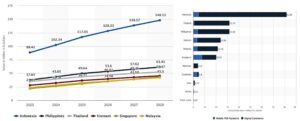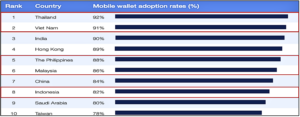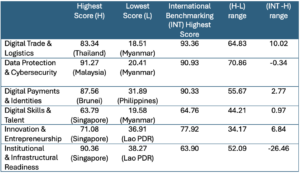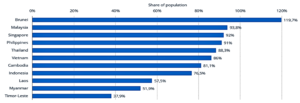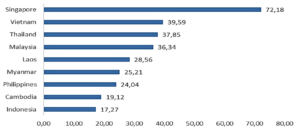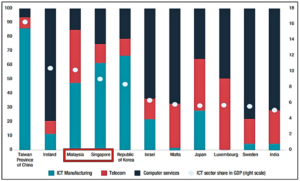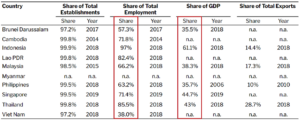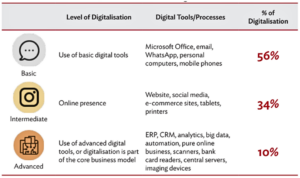03 April 2024
- RSIS
- Publication
- RSIS Publications
- The ASEAN Digital Economy Framework Agreement: Uniting or Dividing?
SYNOPSIS
The ASEAN Digital Economy Framework Agreement launched in September 2023 aims to unite ASEAN nations in fostering digital cooperation and adding up to US$2 trillion to its digital economy by 2030. Among the prerequisites, progress in digital payments and e-wallet adoption is needed and notable in some countries such as Thailand, Vietnam, and Malaysia. Yet, infrastructure disparities, varying internet access, and digital readiness in micro, small and medium enterprises pose challenges. Efforts to harmonise definitions, bridge digital gaps, and ensure policy alignment are crucial to unlocking ASEAN’s digital potential.
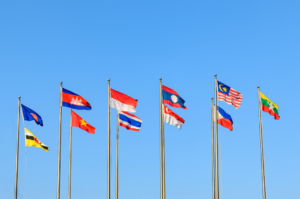
COMMENTARY
In September 2023, the ASEAN economic ministers initiated negotiations for the ASEAN Digital Economy Framework Agreement (DEFA) during the ASEAN Economic Community Council (AECC) meeting. This agreement is hailed as a landmark regionwide digital economy accord and reflects ASEAN’s dedication to a digitally interconnected future.
This framework aims to propel ASEAN’s evolution into a leading digital economy by fostering enhanced digital cooperation, paving the way for regional digital integration, and promoting inclusive growth and development.
Its core elements are Digital Payments and E-Invoicing, Talent Mobility and Cooperation, Cooperation on Emerging Topics, Competition Policy, Cross-border E-Commerce, Digital Trade, Digital ID and Authentication, Cross-border Data Flows and Data Protection, and Online Safety and Cybersecurity. These nine elements underscore collaboration within the digital ecosystem, aiming to unlock the value contribution of ASEAN’s digital economy, which is expected to add up to US$2 trillion to the regional digital economy by 2030.
ASEAN has shown promising advancements that could lead to an integrated digital market. As Graph 1 shows, the adoption of digital payments within ASEAN is on an upward trajectory, with the transaction value of digital payments in several Southeast Asian countries increasing significantly from 2017 to 2022. Notably, digital commerce accounts for the majority of these transactions, with Indonesia emerging as a leader in this domain.
Graph 1. Digital Payment Adoption in ASEAN
Source: Statista (2022)
ASEAN demonstrates strong adoption of global e-wallets, with five of its member states in the world’s top 10 countries in 2022. The region’s evolution in payment systems, notably real-time gross settlement (RTGS), has seen significant global growth, benefiting from Fast Payment Systems (FPS). FPS modernises infrastructure, lowers transaction costs, and fosters competition among payment providers, ensuring seamless fund transfers and promoting interoperability.
The adoption of ISO 20022 message format by domestic Fast Payment Systems (FPS) enhances interoperability, providing standardised transaction representation. Globally, real-time payments have surged, nearing US$195 billion in 2022. FPS facilitates digital payments, fosters competition, and introduces features like QR code acceptance and payment Application Programming Interfaces (APIs), driving the evolution of payment systems worldwide.
Graph 2. Top 10 Countries by Mobile Wallet Adoption Rates
Source: WEF (2022)
As depicted in Graph 2, ASEAN countries stand out as leaders in the adoption of mobile wallets, which play a crucial role in streamlining transactions. Thailand, Vietnam, the Philippines, and Malaysia have shown higher penetration of e-wallets compared to even leading countries like China in this aspect.
Infrastructure Challenges
ASEAN countries lack specific infrastructure targets compared to the EU, focusing on integrated digital market agreements instead. This results in a significant contrast in infrastructure development. The ASEAN Digital Infrastructure Index (ADII) 2021 highlights substantial disparities, with a difference of more than 70 points between the highest and lowest scores in “Data Protection & Cybersecurity” as shown in Graph 3.
Graph 3. ASEAN Digital Integration Index (ADII) Scores
Source: ACCEC (2023)
Therefore, internet infrastructure provision in ASEAN countries varies significantly in both quantity and quality. Penetration rates range from Brunei Darussalam’s 119.7 per cent to Timor-Leste’s 37.9 per cent (Graph 4). Broadband speeds also exhibit notable differences, with Singapore leading at 72.18 Mbps and Indonesia trailing at 17.27 Mbps (Graph 5).
Graph 4. Internet Penetration in Southeast Asia (2022)
Source: Statista (2022)
Graph 5. Median Download Speed of Mobile Internet in Southeast Asia (in Mbps) (2023)
Source: Statista (2023)
The level of digital development within ASEAN countries can be assessed by examining the robustness of their information and communications technology (ICT) ecosystems. Fransman (2010) identifies four key participant groups: network element providers, network operators, platform, content, and applications providers, and final consumers. Graph 6 illustrates this ecosystem. Malaysia and Singapore are the only ASEAN countries represented among the top 10 economies regarding ICT sector value added in GDP and subsector distribution, as shown in Graph 7.
In Malaysia, the ICT sector’s value added is primarily in ICT manufacturing, telecom, and computer services. Singapore’s major share lies in ICT manufacturing and computer services, with telecom contributing the least. However, most other ASEAN countries have nascent ICT ecosystems, emphasising specific layers. Indonesia, for instance, has a robust layer 3 ecosystem supported by tech companies like Gojek and digital banking but faces challenges in layer 1 infrastructure due to reliance on imported technology, impacting the overall digital infrastructure landscape.
Graph 6. Digital Economy Scope in ASEAN
Source: European Commission’s R&D Scoreboard 2023 based on Fransman (2010) framework of ICT ecosystem
Graph 7. Top 10 Economies’ Share of the ICT Sector’s Value Added in GDP (2017)
Source: UNCTAD (2019)
Are the Players Ready?
ASEAN’s micro, small and medium enterprises (MSME) landscape reflects a mixed impression of digital infrastructure readiness. While some areas show promise, others need significant improvement. MSMEs are key stakeholders in DEFA initiatives. They constitute over 97 per cent of total establishments across ASEAN Member States and contribute to 85 per cent of regional employment, as shown in Graph 8. However, their contribution to GDP remains relatively minor due to concentration in labour-intensive and low value-added sectors.
Graph 8. MSMEs Contribution in ASEAN Countries (2020)
Source: ADB (2020)
In Southeast Asia, barriers hinder ASEAN MSMEs’ full potential, especially in developing a Digital Economy Framework Agreement. Varying interpretations of MSMEs due to the lack of standardised definitions pose challenges, as definitions differ across member countries based on criteria like assets, sales turnover, and employee count.
This lack of uniformity may lead to disparities, potentially disadvantaging or advantaging MSMEs across countries. Additionally, there’s a significant digitalisation gap among ASEAN MSMEs, with 56 per cent at basic digital adoption, 34 per cent utilising digital technology for marketing and sales, and only 10 per cent classified as advanced, with the majority located in Singapore.
Graph 9. State of MSMEs Digitalisation (2021)
Source: ERIA (2021)
Going Forward – Ensuring a Level Playing Field
The landscape of ASEAN MSMEs highlights their substantial role in the regional economy. However, several challenges, including the lack of standardised definitions, digitalisation gaps, and limited access to quality certifications, hinder their full potential. Addressing these barriers is crucial to ensure that DEFA creates a level playing field for ASEAN MSMEs, considering their significant market share. To fully realise the US$2 trillion potential of the ASEAN digital economy, comprehensive action is necessary. This includes:
• Identifying the most digitally advanced trading partners, both within and outside the region, is crucial. This recognition of the strong correlation between economic activity and digitalisation will facilitate market access for MSMEs.
• Harmonising the definition of MSMEs across ASEAN countries is vital for effective comparison and understanding of their characteristics.
• Policy harmonisation encompassing infrastructure development, security measures, digital taxation, and the removal of non-tariff barriers.
• Enhanced data on MSMEs.
• Building digital trade relationships with key strategic partners and identifying market leaders, followers, catchers-up, laggards, and tailenders among G20 and other nations are critical steps for advancing ASEAN’s digital economy.
About the Authors
Dr Ibrahim Kholilul Rohman, a Senior Research Associate at IFG Progress, specialises in the impact of digitisation on finance, particularly in insurance and pensions. Previously, as the Chief Economist at Samudera Indonesia, he made substantial contributions to digital governance and EU ICT competitiveness at UNU-EGOV and JRC Directorate Growth and Innovation – European Commission. He is also a lecturer at the School of Strategic and Global Studies, Universitas Indonesia (UI). Kleovan Nathanael Gunawan and Angelique Johanes are economics students at UI.
SYNOPSIS
The ASEAN Digital Economy Framework Agreement launched in September 2023 aims to unite ASEAN nations in fostering digital cooperation and adding up to US$2 trillion to its digital economy by 2030. Among the prerequisites, progress in digital payments and e-wallet adoption is needed and notable in some countries such as Thailand, Vietnam, and Malaysia. Yet, infrastructure disparities, varying internet access, and digital readiness in micro, small and medium enterprises pose challenges. Efforts to harmonise definitions, bridge digital gaps, and ensure policy alignment are crucial to unlocking ASEAN’s digital potential.

COMMENTARY
In September 2023, the ASEAN economic ministers initiated negotiations for the ASEAN Digital Economy Framework Agreement (DEFA) during the ASEAN Economic Community Council (AECC) meeting. This agreement is hailed as a landmark regionwide digital economy accord and reflects ASEAN’s dedication to a digitally interconnected future.
This framework aims to propel ASEAN’s evolution into a leading digital economy by fostering enhanced digital cooperation, paving the way for regional digital integration, and promoting inclusive growth and development.
Its core elements are Digital Payments and E-Invoicing, Talent Mobility and Cooperation, Cooperation on Emerging Topics, Competition Policy, Cross-border E-Commerce, Digital Trade, Digital ID and Authentication, Cross-border Data Flows and Data Protection, and Online Safety and Cybersecurity. These nine elements underscore collaboration within the digital ecosystem, aiming to unlock the value contribution of ASEAN’s digital economy, which is expected to add up to US$2 trillion to the regional digital economy by 2030.
ASEAN has shown promising advancements that could lead to an integrated digital market. As Graph 1 shows, the adoption of digital payments within ASEAN is on an upward trajectory, with the transaction value of digital payments in several Southeast Asian countries increasing significantly from 2017 to 2022. Notably, digital commerce accounts for the majority of these transactions, with Indonesia emerging as a leader in this domain.
Graph 1. Digital Payment Adoption in ASEAN
Source: Statista (2022)
ASEAN demonstrates strong adoption of global e-wallets, with five of its member states in the world’s top 10 countries in 2022. The region’s evolution in payment systems, notably real-time gross settlement (RTGS), has seen significant global growth, benefiting from Fast Payment Systems (FPS). FPS modernises infrastructure, lowers transaction costs, and fosters competition among payment providers, ensuring seamless fund transfers and promoting interoperability.
The adoption of ISO 20022 message format by domestic Fast Payment Systems (FPS) enhances interoperability, providing standardised transaction representation. Globally, real-time payments have surged, nearing US$195 billion in 2022. FPS facilitates digital payments, fosters competition, and introduces features like QR code acceptance and payment Application Programming Interfaces (APIs), driving the evolution of payment systems worldwide.
Graph 2. Top 10 Countries by Mobile Wallet Adoption Rates
Source: WEF (2022)
As depicted in Graph 2, ASEAN countries stand out as leaders in the adoption of mobile wallets, which play a crucial role in streamlining transactions. Thailand, Vietnam, the Philippines, and Malaysia have shown higher penetration of e-wallets compared to even leading countries like China in this aspect.
Infrastructure Challenges
ASEAN countries lack specific infrastructure targets compared to the EU, focusing on integrated digital market agreements instead. This results in a significant contrast in infrastructure development. The ASEAN Digital Infrastructure Index (ADII) 2021 highlights substantial disparities, with a difference of more than 70 points between the highest and lowest scores in “Data Protection & Cybersecurity” as shown in Graph 3.
Graph 3. ASEAN Digital Integration Index (ADII) Scores
Source: ACCEC (2023)
Therefore, internet infrastructure provision in ASEAN countries varies significantly in both quantity and quality. Penetration rates range from Brunei Darussalam’s 119.7 per cent to Timor-Leste’s 37.9 per cent (Graph 4). Broadband speeds also exhibit notable differences, with Singapore leading at 72.18 Mbps and Indonesia trailing at 17.27 Mbps (Graph 5).
Graph 4. Internet Penetration in Southeast Asia (2022)
Source: Statista (2022)
Graph 5. Median Download Speed of Mobile Internet in Southeast Asia (in Mbps) (2023)
Source: Statista (2023)
The level of digital development within ASEAN countries can be assessed by examining the robustness of their information and communications technology (ICT) ecosystems. Fransman (2010) identifies four key participant groups: network element providers, network operators, platform, content, and applications providers, and final consumers. Graph 6 illustrates this ecosystem. Malaysia and Singapore are the only ASEAN countries represented among the top 10 economies regarding ICT sector value added in GDP and subsector distribution, as shown in Graph 7.
In Malaysia, the ICT sector’s value added is primarily in ICT manufacturing, telecom, and computer services. Singapore’s major share lies in ICT manufacturing and computer services, with telecom contributing the least. However, most other ASEAN countries have nascent ICT ecosystems, emphasising specific layers. Indonesia, for instance, has a robust layer 3 ecosystem supported by tech companies like Gojek and digital banking but faces challenges in layer 1 infrastructure due to reliance on imported technology, impacting the overall digital infrastructure landscape.
Graph 6. Digital Economy Scope in ASEAN
Source: European Commission’s R&D Scoreboard 2023 based on Fransman (2010) framework of ICT ecosystem
Graph 7. Top 10 Economies’ Share of the ICT Sector’s Value Added in GDP (2017)
Source: UNCTAD (2019)
Are the Players Ready?
ASEAN’s micro, small and medium enterprises (MSME) landscape reflects a mixed impression of digital infrastructure readiness. While some areas show promise, others need significant improvement. MSMEs are key stakeholders in DEFA initiatives. They constitute over 97 per cent of total establishments across ASEAN Member States and contribute to 85 per cent of regional employment, as shown in Graph 8. However, their contribution to GDP remains relatively minor due to concentration in labour-intensive and low value-added sectors.
Graph 8. MSMEs Contribution in ASEAN Countries (2020)
Source: ADB (2020)
In Southeast Asia, barriers hinder ASEAN MSMEs’ full potential, especially in developing a Digital Economy Framework Agreement. Varying interpretations of MSMEs due to the lack of standardised definitions pose challenges, as definitions differ across member countries based on criteria like assets, sales turnover, and employee count.
This lack of uniformity may lead to disparities, potentially disadvantaging or advantaging MSMEs across countries. Additionally, there’s a significant digitalisation gap among ASEAN MSMEs, with 56 per cent at basic digital adoption, 34 per cent utilising digital technology for marketing and sales, and only 10 per cent classified as advanced, with the majority located in Singapore.
Graph 9. State of MSMEs Digitalisation (2021)
Source: ERIA (2021)
Going Forward – Ensuring a Level Playing Field
The landscape of ASEAN MSMEs highlights their substantial role in the regional economy. However, several challenges, including the lack of standardised definitions, digitalisation gaps, and limited access to quality certifications, hinder their full potential. Addressing these barriers is crucial to ensure that DEFA creates a level playing field for ASEAN MSMEs, considering their significant market share. To fully realise the US$2 trillion potential of the ASEAN digital economy, comprehensive action is necessary. This includes:
• Identifying the most digitally advanced trading partners, both within and outside the region, is crucial. This recognition of the strong correlation between economic activity and digitalisation will facilitate market access for MSMEs.
• Harmonising the definition of MSMEs across ASEAN countries is vital for effective comparison and understanding of their characteristics.
• Policy harmonisation encompassing infrastructure development, security measures, digital taxation, and the removal of non-tariff barriers.
• Enhanced data on MSMEs.
• Building digital trade relationships with key strategic partners and identifying market leaders, followers, catchers-up, laggards, and tailenders among G20 and other nations are critical steps for advancing ASEAN’s digital economy.
About the Authors
Dr Ibrahim Kholilul Rohman, a Senior Research Associate at IFG Progress, specialises in the impact of digitisation on finance, particularly in insurance and pensions. Previously, as the Chief Economist at Samudera Indonesia, he made substantial contributions to digital governance and EU ICT competitiveness at UNU-EGOV and JRC Directorate Growth and Innovation – European Commission. He is also a lecturer at the School of Strategic and Global Studies, Universitas Indonesia (UI). Kleovan Nathanael Gunawan and Angelique Johanes are economics students at UI.





